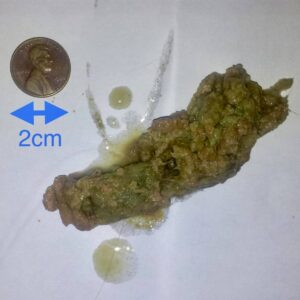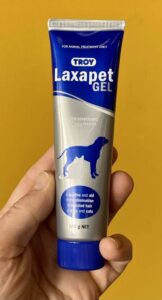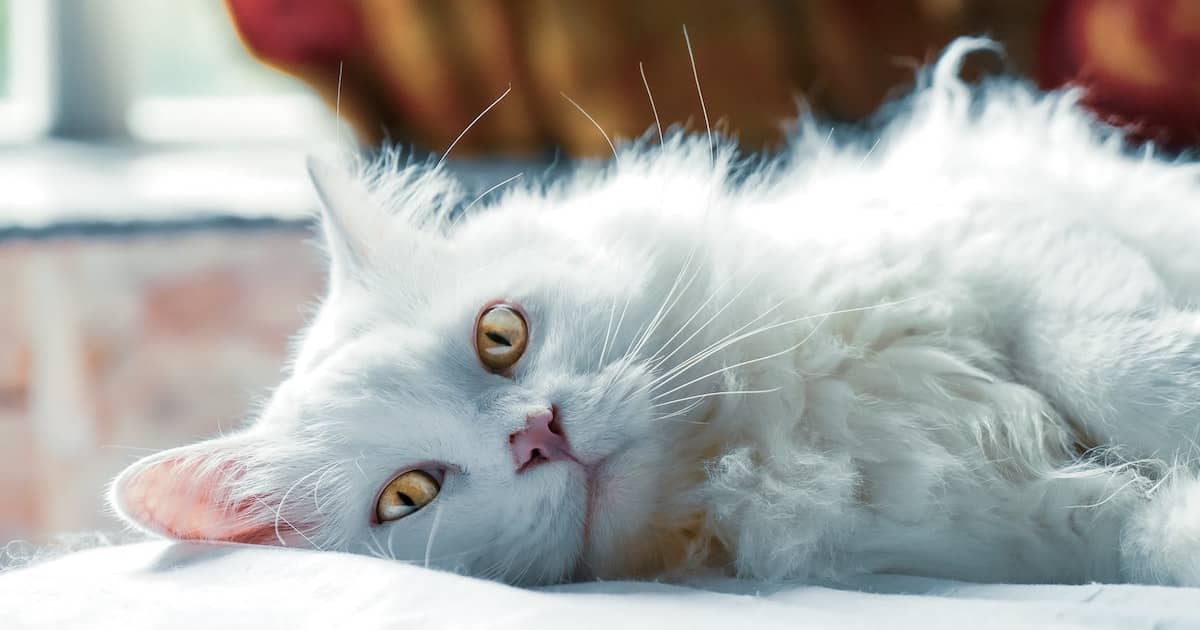For such a common problem, there’s a lot we don’t know about hairballs in cats. It’s yet another example of our tendency to overlook the everyday and focus on the rare. This is to the cost of cats everywhere.
When there’s a lack of hard evidence, we only have experience to go by. So I’ll use mine to help you answer the key questions put to me by cat owners.
What Is A Hairball?

A hairball, or more technically a trichobezoar, is a hard pellet of matted hair found in the gastrointestinal tract. They occur due to hair being swallowed during the normal grooming process, which then accumulates in the stomach.
Eventually the hairball gets to a size where it is vomited up. Such an example is pictured here, surrounded by food. A hairball is much more rarely passed in the faeces.
It’s difficult to know if hairballs are normal or abnormal. My view is that they are an inevitable consequence of grooming. Our task is to prevent them from causing problems.
Help! My Cat Just Vomited A Hairball!
If a cat vomits up hairballs frequently, you need to consider four possibilities:
- That the hairball is a normal accumulation of hair vomited up at the right time
- That the hairball is caused by health problems
- That the hairball is causing health problems
- That your cat is vomiting for another reason, and with it comes the resident hairball
In my experience, point 4 (the hairball as an innocent bystander) accounts for most of the cases I see. To help you recognise it, let’s go through the other three possibilities.
1. How Often Do Cats Throw Up Hairballs?
A cat passing hairballs normally will:
- Vomit no more than weekly
- Have a single rapid effortless vomit, and be immediately hungry afterwards
- Have no other health problems
2. When Hairballs Are Secondary To Illness
Underlying health problems that could lead to hairball problems are mainly of the skin or gastrointestinal tract.
Skin problems mostly relate to what we call overgrooming. Historically, this has been labelled a psychological problem, but the more we know the more we understand it’s usually a response to itchy skin. If your cat’s coat does not look healthy, click here for a deep dive into the causes of overgrooming in cats.
Gastrointestinal problems are a mixed bag, ranging from parasites to allergies to food responsive disease. Again, if your cat vomits more frequently, is underweight or has loose stools, click here for a discussion of the possible causes.
3. How To Know If A Cat Has A Hairball Stuck
A cat with a hairball large enough to cause problems will usually only have the following symptoms:
- Frequent unproductive vomiting
- Poor or no appetite
However, these signs are vague and caused much more often by other serious conditions.
Therefore, unless your vet can feel a lump in your cat’s belly, they need to consider all the causes of vomiting in cats, plus those of not eating. And given how often people confuse coughing and vomiting in cats, don’t rule this out either
A clue that looking for a hairball might be a good idea can come from the patient’s history. These cats are more likely to:
- have a history of hairball problems
- have a highly shedding coat like the one above
- have a long coat
- be an older cat
4. When Hairballs Aren’t The Cause
Vomiting is probably the number one sign of a sick cat, and has hundreds of possible causes. Many of these cats will have identical risk factors to those prone to hairballs, just to make it harder.
Most of the cats I see who are brought to me for a hairball problem actually have a vomiting problem. Probably top of the list is pancreatitis because it’s so hard to diagnose. It’s just that there’s often a hairball in their stomach when they vomit.
Therefore, there’s no good alternative to a thorough workup, usually via blood testing and ultrasound examination to begin. Only once we draw a blank might we be prepared to blame the hairball itself.
How to Help A Cat Pass A Hairball

If a cat’s problems are caused by a hairball, you can try to help it pass. Don’t do this unless you’re absolutely sure, as you will waste valuable time.
Please note that cats do not commonly pass hairballs in their litter tray. I am personally dubious that cat laxatives like the one pictured here actually do very much. However, if your cat is bright, happy and eating, there’s probably no harm in trying.
Just follow the instructions on the package. I am not aware of any other remedy that might work. However, these products are most useful for prevention anyway.
How To Prevent Hairballs In Cats
Unlike the unreliability of treating a hairball, there are effective ways to prevent them forming.
The first is to remove as much dead hair as possible before your cat does. This will require daily brushing with a slicker brush or similar. If you started while your cat was a kitten, they will usually enjoy it.
It’s messy. I had a cat like this once, and I kept an old theatre gown near my armchair to protect my clothes.
The second is diet. Royal Canin, Hills and no doubt others make effective hairball preventing diets. They work by removing the hair from the stomach before it balls up. Most use either cellulose fibre or psyllium.
The third, of course, are hairball treatment products like pictured above.
Can A Hairball Kill A Cat?
I have seen two cats who would have died without their hairballs being surgically removed. That’s not many over 27 years but it does happen.
For these cats, their owners agreed that the risk was too high to ever let it happen again. Therefore, we took the nuclear option: clipping.
Every six months for life, these cats were booked in for a full shave under sedation. It kept them free of problems, even if they did look a bit strange.
But the main way a hairball can cause death is through inaction. This study contains one cat who died through a delay in treatment and another who was euthanased due to a mistaken belief it was a tumour. And there are also those cats where a much more serious vomiting or coughing problem is written off as ‘hairballs’.
I hope all this helps, no matter whether you have a minor or major problem. But in closing I’ll repeat: hairballs are more often suspected than actual culprits. Keep an open mind!
Have something to add? Comments (if open) will appear within 24 hours.
By Andrew Spanner BVSc(Hons) MVetStud, a vet in Adelaide, Australia. Meet his team here. The information provided here is not intended to be used as a substitute for going to the vet. If your pet is unwell, please seek veterinary attention.


Hi,
My cat was just diagnosed with frim mass in abdomen. White cells are low they gave him an antibiotic shot and suggest ultrasound. I am wondering if it could be a hairball. He is long hair and would get them regularly. He has not had any in awhile he has lost weight and not as active. Eating drinking going to the bathroom all just fine. I am just so scared right now.
Hi Kathleen. Like I say in the article, an ultrasound examination should resolve the issue.
My big guy tries to get them up but sometimes just ‘dry heaves’. I worry that a really big hair ball is down there somewhere, but I don’t want to take him to the vet unnecessarily. He has NO problem getting food down (it’s his favorite ) and no problem with bathroom time. I notice he starts trying to get them up once I give him the hairball treats in his wet food. Should I not give it to him anymore? Or is it helping? ♀️
Good Bless!
Hi Kaycie. My concern is how you can be sure that his dry heaves are in fact being caused by a hairball, and not a respiratory problem. I think a check up is in order unless you are absolutely certain.
Thank you for the hairball comments. I have a abandoned make cat that the vet believes Is 7 – 10 years old. I’ve had him for 3 years now and he supposedly has asthma so I have him on inhalers that the vet subscribed ,I always thought he just couldn’t get that hairball out but my question to you is when he has his asthma cough is that when I give him a puff of the inhaler or when he’s,down coughing cuz when I give it to him when he’s coughing he seems to be choking? And he fights with me ..but only when he’s coughing and I try to give him the inhaler other times he just lays back and he’s fine ?
Hi Brenda. The best advice will only be possible by an examination of your cat, but generally I use the inhaler just like in people as a routine preventative. The idea is that by keeping the bronchioles dilated, the problem doesn’t get so bad in the first place. It’s also a lot easier if you make it into a routine as your cat will eventually accept it as part of their day, such as before a snack.